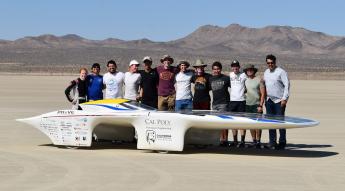Solar Car Created by Cal Poly Students Reaches 51 MPH, Just Shy of World Record

PROVE Lab students, who designed the car to reach 65 mph, will fine tune the vehicle and try again in the summer of 2020
In a “Star Wars”-like setting in the Mojave Desert, a solar car created by a team of Cal Poly students eclipsed 50 mph this month, just shy of a world record.
While the team did not break the 56-mph record set in Japan in 2014, it overcame many obstacles to reach a clocked speed of 51 mph.
“It shows that with a little improvement, we can easily go 65 mph,” said Lacey Davis, an aerospace engineering student who drove the car.
Davis is a member of Cal Poly’s Prototype Vehicle Laboratory, also known as the PROVE Lab. For roughly three years, she and her teammates have worked to build and refine a solar-powered car that could break the world speed record. A little over a week ago, the team hoped to do just that at El Mirage Lake, located about 50 miles northwest of Victorville in San Bernardino County.
The idea to pursue a world record came from Graham Doig, a former aerospace engineering faculty member who had created record-breaking solar cars himself. Last year, electrical problems hampered the car, named Dawn, and the anticipated record attempt was called off. Then Doig, the mentor, left the university for a job in private industry.
His successor, Aerospace Engineering Professor Paulo Iscold, better known for creating airplanes that break records, said he “saw it was a good project for the students.” The first challenge entailed reworking the electrical system that had stalled the car last year. But other systems needed retooling as well, Iscold said. And, by the time the car was ready, the optimal time to go for the record — the longest day of the year, June 21, when energy from the sun is strongest — had long passed.
Still, the team went forward and tested the car in Santa Margarita earlier this month. Then it traveled to El Mirage, where the Southern California Timing Association has performed timed speed runs for 50 years. In that other-worldly setting, Davis squeezed into the car’s cockpit and set out to make history.

“It felt like I was driving on another planet — like pod racing on Tatooine!” she said, referring to the scene in “Star Wars: Episode I – The Phantom Menace.” “ I think that actually suppressed my fear of hitting an object or running the car off of the track, because it was so open and vast on the El Mirage lakebed. It was also inspiring to know how many other world records and vehicle testing had been done out there for other major projects.”
The car had a speedometer that Davis could see. Meanwhile, members of the team verified the speed by comparing it to a chase car. While the car came up just shy of the record, Iscold said that setback provided a good lesson for the team.
“Not everything in life goes exactly as planned,” he said. “Overcoming failure has become part of the engineering process.”
The team did have to hurdle some challenges — including Doig’s departure and the electrical issues. “Overcoming those was unfortunately very taxing on the team,” said Davis, an aspiring astronaut from Salinas, California. “However, we did get some new faces to the project, and their dedication to persevere through the challenges with us made it that much more obvious how passionate they were about Dawn and engineering.”
The team did get Dawn to the desert, an improvement over last summer. So this year’s effort, Davis said, was an important building block.
“We plan to try again next year because there are only a few changes that actually need to be made to the car’s solar array and electrical system to get those last few miles per hour in,” she said.


